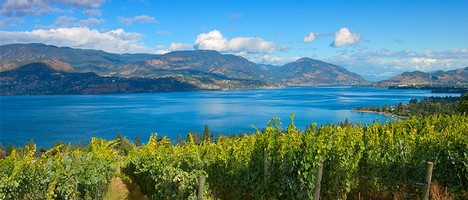Okanagan Valley Terroir

Over the last decades, producers in the Okanagan Valley have undertaken great efforts to establish this unique and breathtakingly beautiful valley as North America’s newest premium wine‐growing region. The diversity of vines that thrive in varied microclimates here provides winemakers with a multitude of options to express their creative talents and technical expertise. The region has attracted winemakers from around the world and is now home to vintners from France, Australia, California, New Zealand and South Africa.
The Okanagan Valley is a 124 mile‐long trough that extends north from the 49th parallel into the central southern interior of British Columbia. The valley is lined with multiple bedrocks, their floors and lower slopes overlaid with the rich silt, sand and gravel over 10,000‐year old glacial deposits.
The northern end of the Sonoran Desert eco-zone, which extends all the way south to Mexico, just barely reaches across the United States‐Canada border to British Columbia, up to the south Okanagan towns of Osoyoos and Oliver. Referred to as Canada’s only pocket desert, the arid climate of the southern British Columbia interior shapes the geographical landscape for viticulture.
The climate of the Okanagan Valley is governed by the region’s location in the lee of the Coast Mountain Range. These mountains, with peaks of over 8,000 feet, are effective weather blocks. While the weather west of the Coast Range in Vancouver is wet, a rain shadow effect is produced eastward in the Okanagan Valley. Rainfall is lowered to an annual average 16 inches in the north, near Kelowna, and eight inches in the south, around Osoyoos. Summer months are dry and warm with rainfall usually in the form of brief showers. June is the wettest month. Hot periods occur when dry continental air invades the area from the desert region to the southeast, in the United States. Temperatures can often reach 95° Fahrenheit or more. The average temperature during the warmest month in the south Okanagan is 71.6°F. By way of comparison, the average temperature during the warmest month in Bordeaux, France is 67.3° Fahrenheit, and annual precipitation is 31 inches. In the Napa Valley, California, the average temperature in the warmest month is 66.4° Fahrenheit, and the annual rainfall is 25.6 inches.
The Okanagan Valley falls in the Northern Hemisphere’s wine‐growing belt and shares the same
latitude as Northern German and French vineyards. While referred to as a cool‐climate wine
region, unique microclimates exist throughout the valley. The northern tip of the Okanagan
Valley is at 50°N, and the southern tip is at 49°.
A chain of pristine blue lakes, fed by several rivers, runs the length of the Valley, moderating both the intense summer heat and chilly winter air. Viticulturists throughout the Okanagan depend on the moisture moderated climate. Intense sunlight and minimal rainfall allow the grapes to ripen to their full maturity, while cool nights help them to retain high acidity.